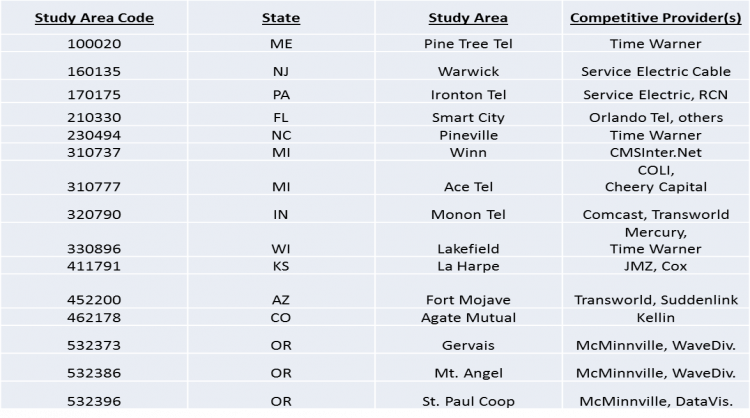FCC Publishes List of Rate-of-Return (ROR) ILEC Study Areas Projected to Lose Universal Service Support
August 7, 2015 | by Andrew Regitsky

In a Public Notice in Docket 10-90, released on July 29th, the FCC is seeking comments regarding the methodology it plans on using to determine rate-of-return ILEC study areas subject to 100 percent overlap by unsubsidized on-ILECs offering competing voice and broadband services.
The Public Notice also publishes a preliminary list of these study areas determined through this methodology.
Why is this information important? It is important because in these identified study areas, the ROR ILEC is set to lose all its high-cost universal service support.
Here is the background:
In its 2011 Cost America Fund Order in Docket 10-90, the FCC adopted a rule to eliminate high-cost universal service support in ILEC study areas where an unsubsidized competitor or a combination of unsubsidized competitors offers voice and broadband services that meet the Commission’s service obligations throughout the entire study area. The Commission defined an unsubsidized competitor as “a facilities-based provider of residential fixed voice and broadband service that does not receive high-cost support.”
To be considered an unsubsidized competitor for purposes of the 100 percent overlap analysis, a fixed broadband provider must offer service in accordance with the Commission’s service obligations on speed, latency, and usage allowances. In December 2014, the Commission adopted a new minimum speed standard for carriers receiving high-cost support: they must offer actual speeds of at least 10 Mbps downstream and 1 Mbps upstream (10/1 Mbps). Therefore, the Commission used 10/1 Mbps as the speed threshold in the preliminary 100 percent overlap analysis.
In the 2011 Order, the Commission sought comment on a proposed methodology for determining whether a study area is 100 percent overlapped by an unsubsidized competitor and directed its Wireline Competition Bureau to publish a finalized methodology for determining areas of overlap and a list of companies for which there is a 100 percent overlap. That methodology and the list of ILECs affected are specified in the Public Notice.
The methodology is based on FCC Form 477 which lists carrier facilities deployment on a census block data. The Commission painstakingly went through the data to include only instances of 100 percent overlap by non-ILEC facilities-based carriers. More details of the methodology can be found at http://transition.fcc.gov/Daily_Releases/Daily_Business/2015/db0806/DA-15-868A1.pdf
Once the Commission determined the actual study areas, it published the list of study areas in which an ILEC competitor is providing unsubsidized services and where, if this methodology becomes law, the ILEC will lose all high-cost support. That list is below:
Return Study Areas Subject to a 100 Percent Overlap by an Unsubsidized Competitor or Combination or Unsubsidized Competitors
Industry comments on the methodology are due on August 28th. The companies operating in the affected study areas, both the ILECs and the unsubsidized competitors, are invited to review and, if necessary, confirm or refute the results of the Commission’s preliminary analysis.
Specifically, ILEC competitors should address whether they currently offer, to all locations within the blocks reported on Form 477 and which overlap the ILEC’s study area, (1) fixed voice service at rates under the 2015 reasonable comparability benchmark of $47.48, and (2) fixed broadband service at actual downstream speed of at least 10 Mbps and actual upload speed of at least 1 Mbps; with latency suitable for real time applications, including Voice over Internet Protocol; with usage capacity that is reasonably comparable to offerings in urban areas; and at rates that are reasonably comparable to those in urban areas.
ROR ILECs identified on the preliminary list of 100 percent overlapped study areas also are free to submit evidence that an unsubsidized competitor does not offer service to all locations in the census blocks identified.
Remarkably, this would be the first time that I can remember in which an ILEC lost universal service support because a competitive is providing “carrier of last resort” services without subsidies. It should be interesting to see if any or all the affected ILECs challenge the Commission’s findings.
By Andy Regitsky, CCMI


